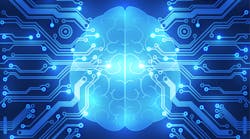Artificial intelligence is dominating headlines around the world. But how practical is it? Can it be integrated into business operations in a way that boosts the bottom line without introducing costly errors?
Some companies in the mechanical contracting sector believe it can. “AI presents opportunities to increase efficiency, reduce costs, and improve the safety and quality of our operations,” said Jeff Danley, Associate Technology and Innovation Consultant at Burns & McDonnell. “We are in the early stages of exploring its use and look forward to integrating innovative technologies into our workflows.”
Every job is slightly different, and AI is able to catch those differences and adjust its instructions. “So far, it’s been very effective in applying a common method of work to very different environments,” said Buckley. “That helps our technicians make sure the steps they take are exactly what needs to be done to be safe and effective.”
An example of a method statement would be a preventive maintenance protocol for a rooftop unit. The procedure needs to deal safely with the inherent risks, while being flexible enough to provide guidance on what to do when complications arise.
AI allows the company to deal with issues early in the process, often at a time when only minor adjustments need be made. In contrast, picking up a problem maybe three months down the road during routine preventative maintenance can result in a much more costly repair or replacement as the problem has grown much bigger.
As an example of such a scenario, the company posits a hypothetical 40-story downtown office building in which critical elements of the HVAC system are about to go out. AI will allow the company to spot any developing problem with the system so that it can be fixed before“This kind of fault detection and diagnostics has become a lot more sophisticated now than it was a few years ago, thanks to improvements in AI,” said Buckley. “What the latest generation of AI is allows us to do is to go much heavier on the diagnostics.”
Safety checks
TDIndustries is also using AI to measure and enhance its safety systems and engagement. “A company of our size completes hundreds of thousands of safety engagement processes over the course of a year,” said Jamie Dabbs, CSP, the company’s Vice President of Safety, Health, and Environmental. “We need technology like this to be a resource multiplier to help us define, analyze, measure, and control safety processes and scale our large volume of safety engagement. We started using AI to help us score pre-task safety plans through our app (SmartTagIt by FactorLab) in 2019. The AI provides an analysis that humans could not do, or not do as efficiently or at this scale.”
This approach taught the AI model to score text-based pre-task safety plans by first using TD Safety managers to manually score 2,000 completed plans.
The AI is able to take unstructured human data and group it in ways that allow for structured reporting. That allowed the company to be more insightful, intentional, and predictive. “Prior to having this safety technology, the work of the EHS professional was a little more hit or miss,” said Dabbs. “They would use a paper checklist and create a manual gap analysis. The benefits from AI derive from its service as a resource multiplier, allowing our personnel to be more effective by being extremely intentional with their time.”
“Now that we have advanced,” he says, “SmartTagIt’s Large Language Model helps us fill in knowledge gaps and add specific, critical steps that could have been missed as we build our pre-task safety plans.”
Larger Issues
For companies large and small, AI offers a new way of sharing information throughout the enterprise, and new ways of working and communicating. Here are some special areas of business operations for which AI is now being utilized in this way:
- Scheduling and resource management - “AI can optimize scheduling and resource allocation based on historical data, real-time inputs, and predictive modeling,” said Danley. “Intelligent algorithms can consider various factors like resource availability, project deadlines, and workforce skills to create efficient schedules. AI will also help with demand forecasting and mitigating potential resource conflicts.”
- Document management - “Integrating generative AI and the capabilities presented by a Large Language Model (LLM) has potential to have a positive impact on how our business development teams work with RFPs,” said Danley. “AI can quickly read and interpret RFP requirements and identify previous similar works, which will help with benchmarking key elements of our response. With enough training, the system will also generate a win probability score for each new RFP loaded into the system.”
Avoiding Risk
New initiatives are not without peril. “While it’s easy to get excited about the potential benefits introduced by AI, many unknowns still exist,” said Danley. “Our tech and innovation teams are exploring new use cases for AI in the office and on our job sites. However, before moving forward with any implementation we will conduct thorough reviews to assess any risks or compliance concerns.”
Danley points to two areas of concern:
- Data security - “We take the protection of our internal data and our clients’ data very seriously,” said Danley. “When we hear major tech companies make statements such as, ‘Our AI is learning things that it was not trained to understand,’ that gives us some concerns about what might be happening behind the scenes with commercially available AI systems.”
- Legal and IP considerations - “AI is breaking new ground in many industries,” said Danley. “Legal precedence has not been set in many cases. If AI is used in any part of a construction project, and an adverse event happens, could any part of the AI system be at fault? If so, who bears the liability? The developer, the system operator, the designer, engineer, or the builder?”
The Human Factor
As impressive as it is, AI Is not perfect. In these early days of the technology, companies must be vigilant about spotting and correcting errors in its output. “We can’t blindly follow what the AI says,” said Buckley. “A human needs to be a buffer, because AI, being a learning model, can give erroneous answers. I'm sure it will get better in the future, but no matter the quality of results, today it is important that we take ownership for our own work.”
Despite that risk, the new technology allows companies to move faster and increase profitability. “AI allows us to be safer as well,” said Buckley. “It ensures that certain conditions get recognized that we might otherwise overlook in the rush of business.”
Sidebar: The Green Revolution
While AI introduces many operating efficiencies at the plant level, at a larger societal level it is expected to be instrumental in bringing about an increase in sustainability, efficiency and comfort.
“AI will be a game changer in allowing us to move forward toward cleaner, more efficient systems,” said Buckley. “If we look at the bigger picture of sustainability, it is a fact that the built environment contributes considerably to our energy consumption and has a huge impact on people's individual well-being. So, anything that we can do that will result in our buildings performing more effectively and efficiently, and being able to use resources in a more effective and considerate way, is important.”
AI will be one welcome solution to the decades old problem: How can the construction industry develop smart buildings that provide monetary and energy savings? To date, said Buckley, the industry has been thwarted by the proliferation of data that exists inside modern buildings, and the real limits of the human mind. “A typical large facility may have 30,000 sensor points or more across different pieces of equipment,” he said. “That data is often held in very disparate systems that don't talk to each other. That makes it very difficult for our industry to deliver on its sustainability promise. AI is super important because it provides the real capability to deal with all of that unstructured data and make sense of it in a way that we have not been able to do because we have not had the necessary human resources.”
Today, thanks to AI, conditions are changing. “For the first time in 20 years I believe we will soon be able to deliver what we've been promising to do across our large portfolios,” said Buckley. “We're on the cusp of a revolution in real estate and facility construction, and it’s an exciting place to be.”
Phillip M. Perry is a journalist and syndicated columnist who lives and works in New York City. He can be reached at linkedin.com/in/phillipmperry.





